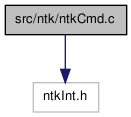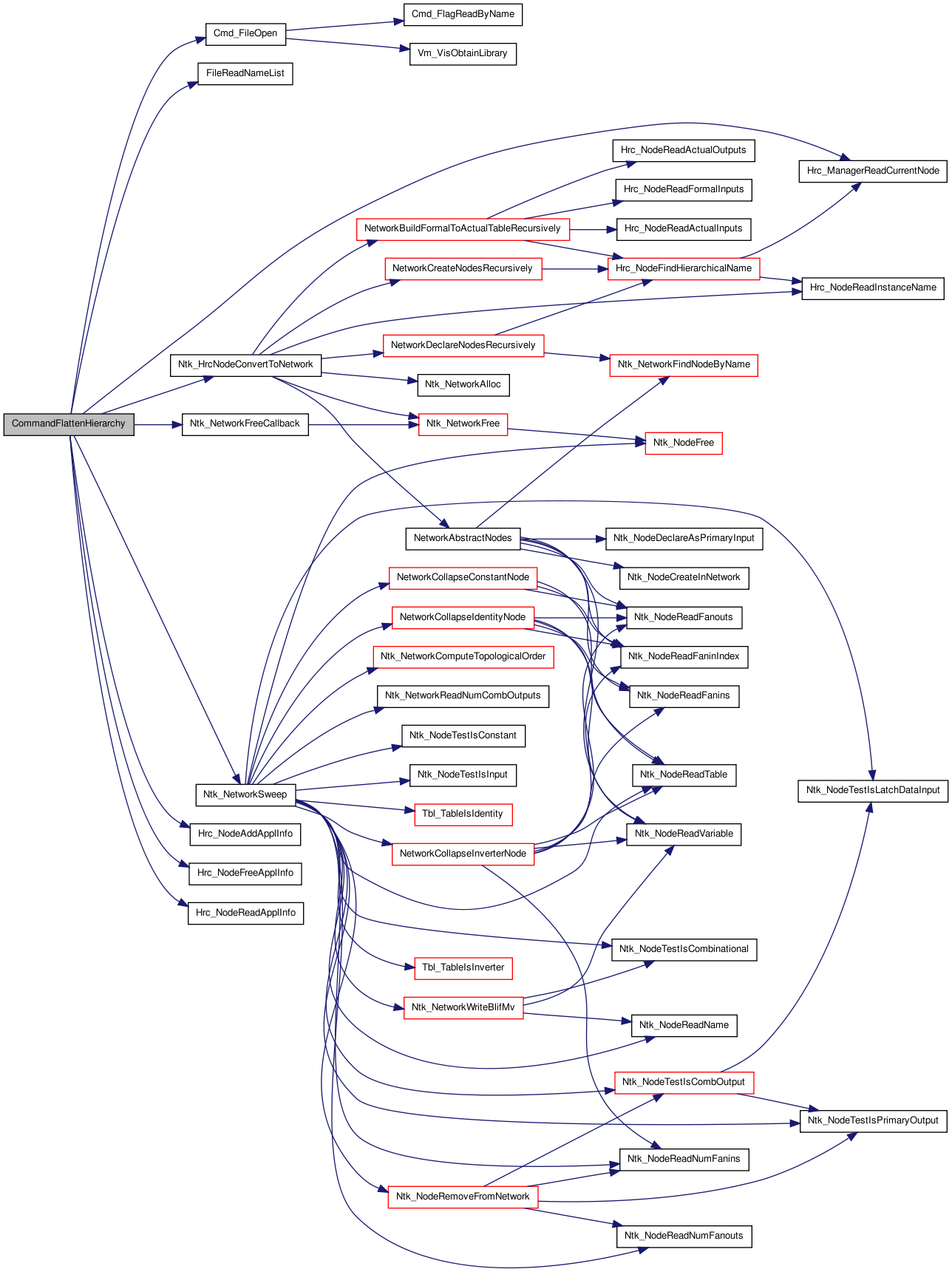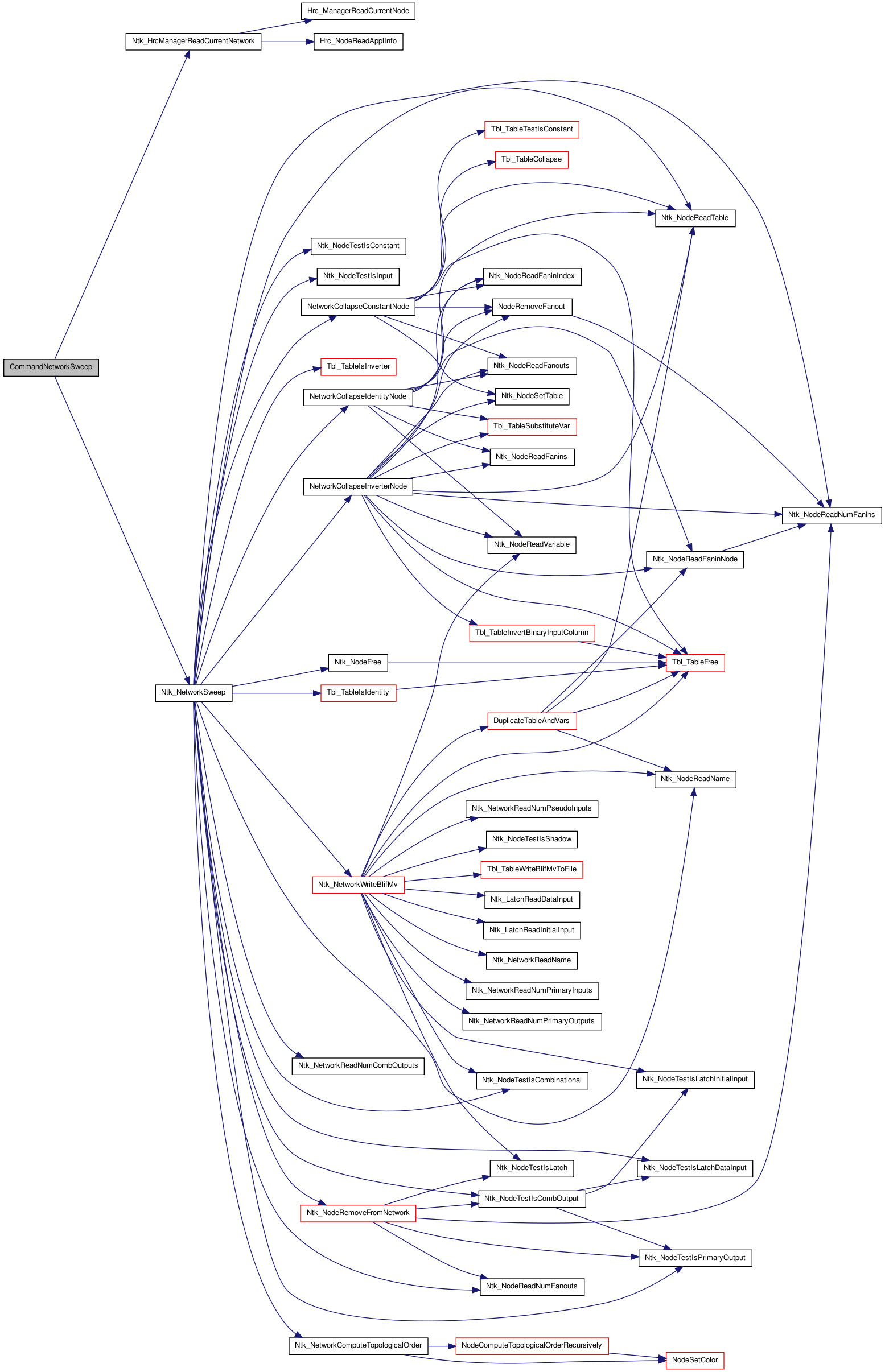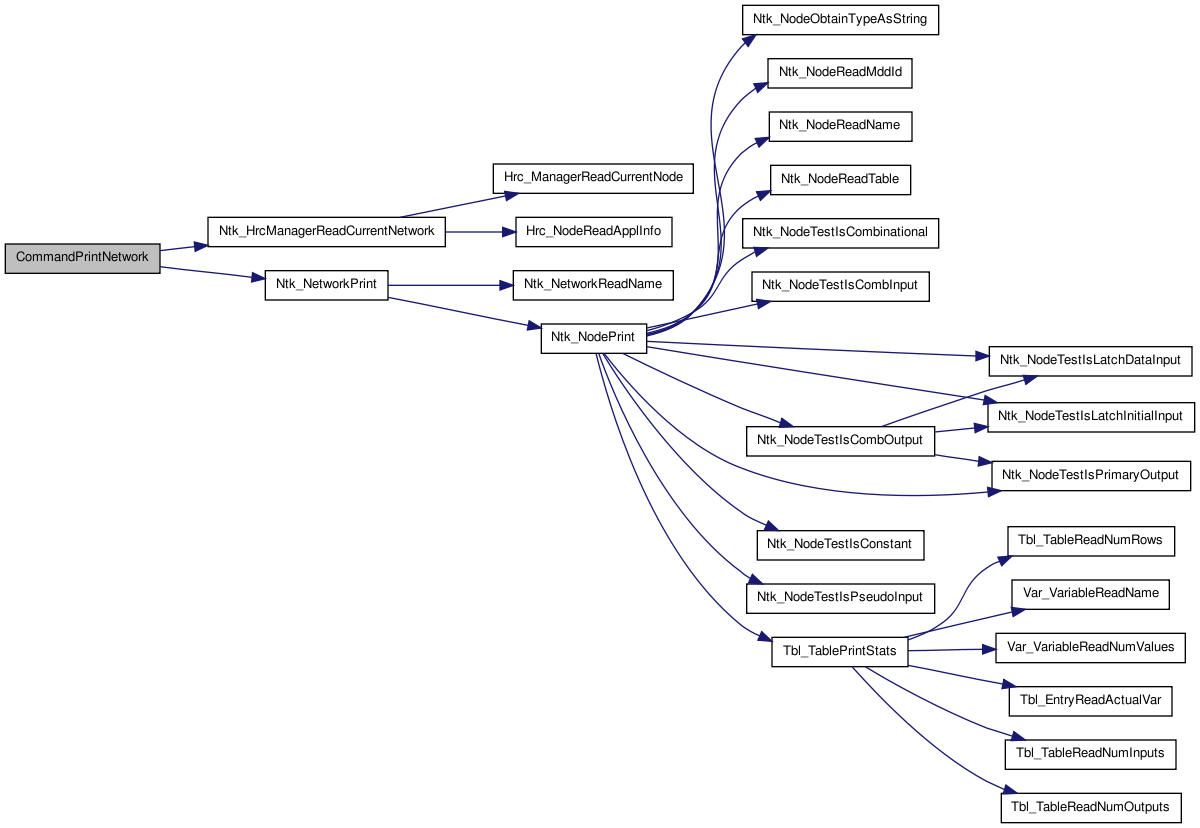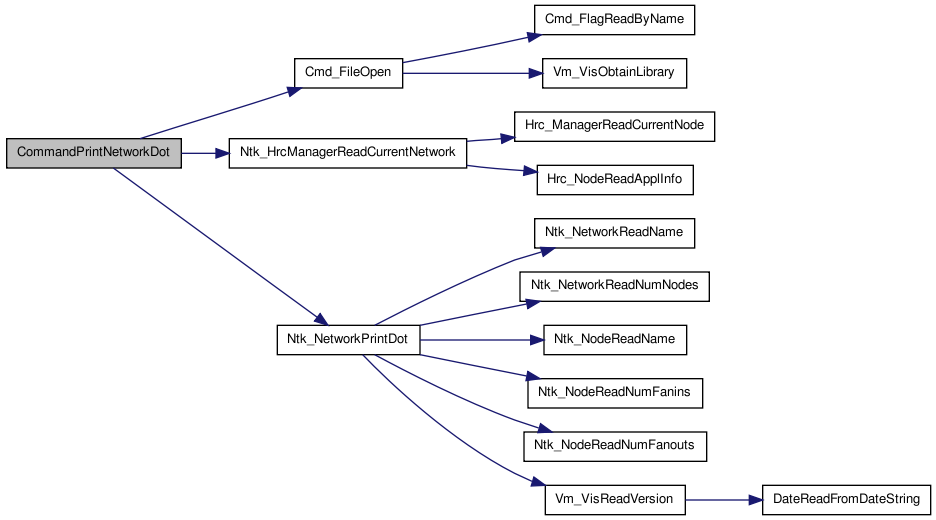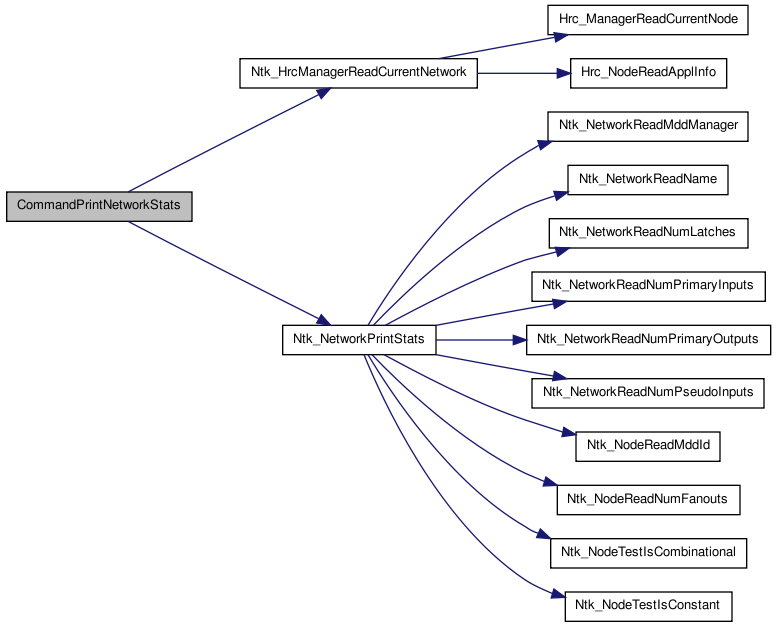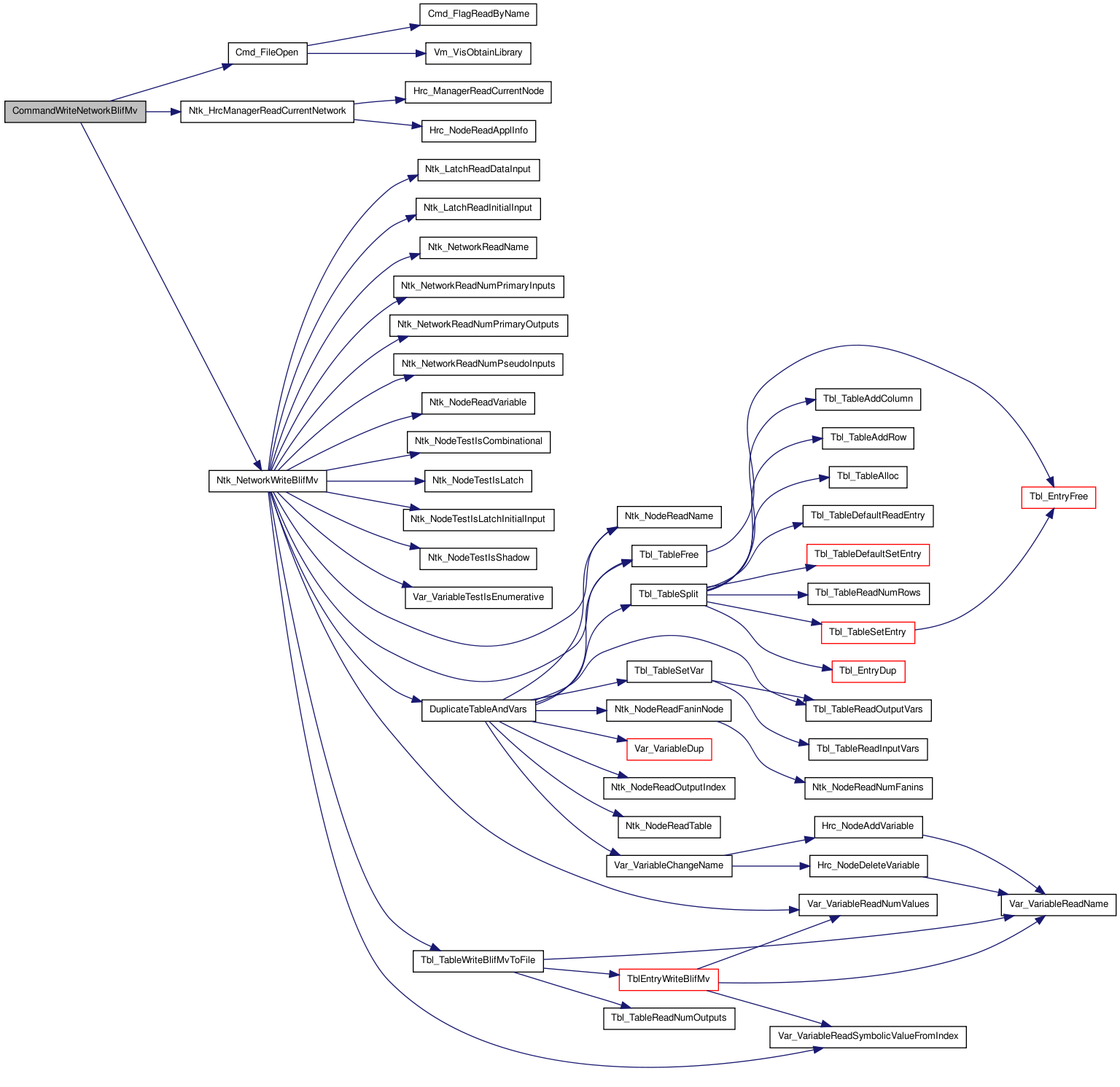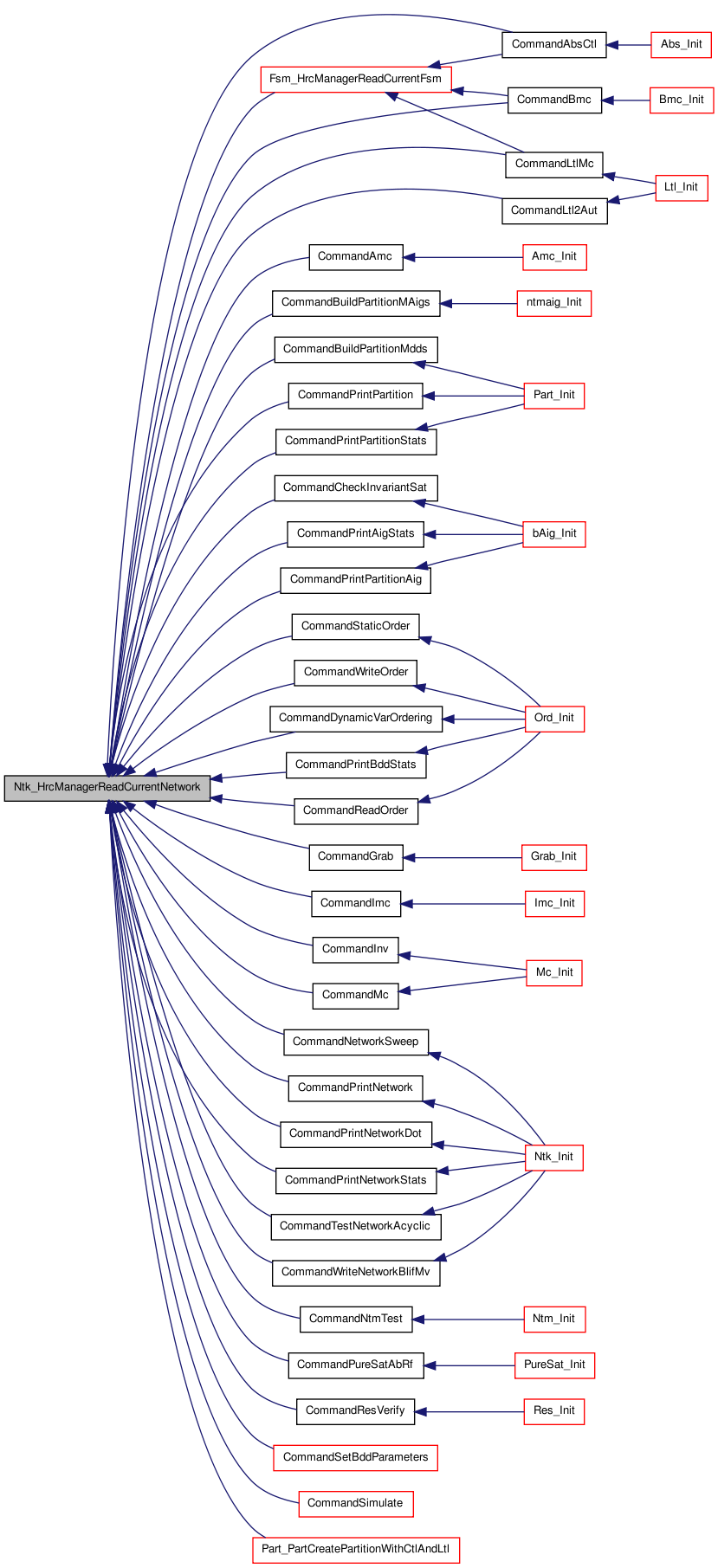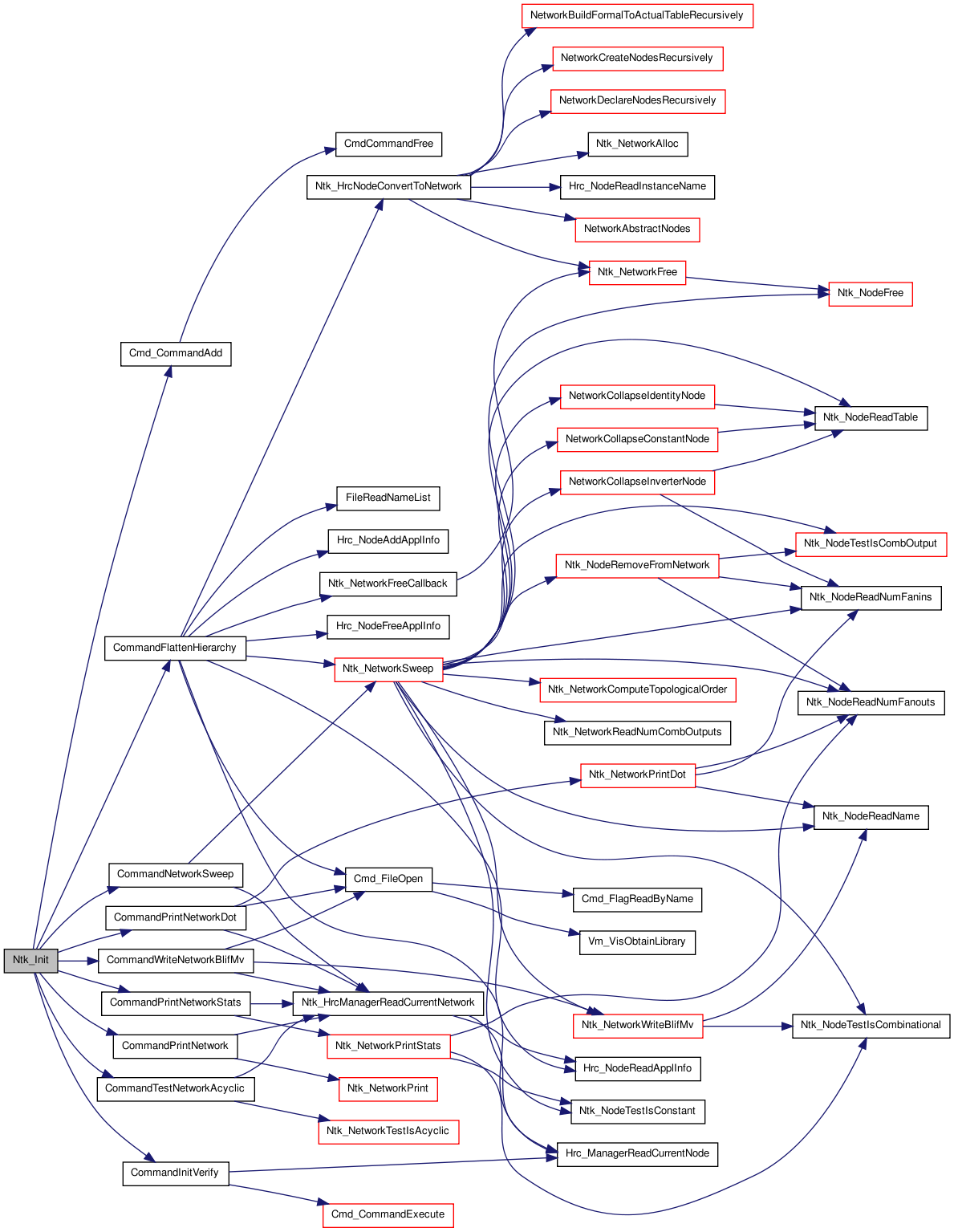#include "ntkInt.h" Include dependency graph for ntkCmd.c:
Include dependency graph for ntkCmd.c:Go to the source code of this file.
Defines | |
| #define | STATE_TEST 0 |
| #define | STATE_WAIT 1 |
| #define | STATE_IN 2 |
| #define | MAX_NAME_LENGTH 200 |
Functions | |
| static int | CommandPrintNetworkStats (Hrc_Manager_t **hmgr, int argc, char **argv) |
| static int | CommandPrintNetwork (Hrc_Manager_t **hmgr, int argc, char **argv) |
| static int | CommandPrintNetworkDot (Hrc_Manager_t **hmgr, int argc, char **argv) |
| static int | CommandWriteNetworkBlifMv (Hrc_Manager_t **hmgr, int argc, char **argv) |
| static int | CommandFlattenHierarchy (Hrc_Manager_t **hmgr, int argc, char **argv) |
| static int | CommandTestNetworkAcyclic (Hrc_Manager_t **hmgr, int argc, char **argv) |
| static int | CommandInitVerify (Hrc_Manager_t **hmgr, int argc, char **argv) |
| static int | CommandNetworkSweep (Hrc_Manager_t **hmgr, int argc, char **argv) |
| static boolean | FileReadNameList (FILE *fp, lsList *nameList, int verbose) |
| void | Ntk_Init (void) |
| void | Ntk_End (void) |
| Ntk_Network_t * | Ntk_HrcManagerReadCurrentNetwork (Hrc_Manager_t *hmgr) |
Variables | |
| static char rcsid[] | UNUSED = "$Id: ntkCmd.c,v 1.19 2010/04/09 23:44:05 fabio Exp $" |
| int | NtkDebug |
Define Documentation
Function Documentation
| static int CommandFlattenHierarchy | ( | Hrc_Manager_t ** | hmgr, |
| int | argc, | ||
| char ** | argv | ||
| ) | [static] |
Function********************************************************************
Synopsis [Implements the flatten_hierarchy command.]
CommandName [flatten_hierarchy]
CommandSynopsis [create a flattened network]
CommandArguments [\[-a <file>\] \[-b\] \[-h\] \[-s\] \[-v #\]]
CommandDescription [Creates a flattened network from a hierarchical description. The flattened network encompasses everything from the current node of the hierarchy (reached by the command cd), down to and including the leaves. It creates a view with the hierarchy removed, but retains the multi-level logic structure. The resulting flattened network is stored with the current node. Every table in the flattened network is checked whether it is completely specified and deterministic. This is the starting point for verification related commands.
A limited form of abstraction can be done by providing a list of variables to treat as primary inputs. See the information under <file> below.
The verification part of VIS requires the functions specified by the BLIF-MV tables to be completely specified and deterministic. These conditions are checked during the flattening process; if a table is found that is incompletely specified or is nondeterministic, then an error message is written and a flattened network is not created. The exception to this rule is tables specifying "pseudo inputs"; these are tables with no inputs, and a single output that can take more than one value. Such tables are generated by vl2mv to model the "$ND" construct in Verilog.
If this command is invoked a second time from the same point in the hierarchy, the previous network is deleted and a new one is created. This is the tactic to follow if you want to change some aspect of the current network, such as MDD variable ordering or image_method.
Command options:
- -a <file>
A file containing names of variables, used to specify which variables to abstract. The name of a variable is the full hierarchical path name, starting from just after the current hierarchy node (i.e., if the current node is foo, and you want to refer to variable x in foo, then just use x). A variable should appear at most once in the file. Each variable name should appear at the beginning of a new line, with no white space preceding it. The end of a variable name is marked by white space, and any other text on the rest of the line is ignored. Any line starting with "#" or white space is ignored. A sample file is shown here.
# variables to abstract to model check liveness property choosing0 p0.pc
For each variable x appearing in the file, a new primary input node named x$ABS is created to drive all the nodes that were previously driven by x. Hence, the node x will not have any fanouts; however, x and its transitive fanins will remain in the network.
Abstracting a net effectively allows it to take any value in its range, at every clock cycle. This mechanism can be used to perform manual abstractions. The variables to abstract should not affect the correctness of the property being checked. This usually simplifies the network, and permits some verification tasks to complete that would not otherwise. Note, however, that by increasing the behavior of the system, false negatives are possible when checking universal properties, and false positives are possible when checking existential properties.
A convenient way of generating the hierarchical variable names is by using the write_order command. Note that abstracting next state variables has no effect.
- -b
This option has no effect any longer.
- -h
Print the command usage.
- -s
Do not perform a sweep.
- -v #
Print debug information.
0: (default) Nothing is printed out.
>= 2: Prints the variables read from the input file.
]
SideEffects []
Definition at line 631 of file ntkCmd.c.
{
int c;
Ntk_Network_t *network;
char *fileName = NIL(char);
int verbose = 0; /* default */
int sweep = 1;
lsList varNameList = (lsList) NULL;
Hrc_Node_t *currentNode = Hrc_ManagerReadCurrentNode(*hmgr);
/*
* Parse the command line.
*/
util_getopt_reset();
while ((c = util_getopt(argc, argv, "a:bhsv:")) != EOF) {
switch (c) {
case 'a':
fileName = util_optarg;
break;
case 'b':
break;
case 'h':
goto usage;
case 's':
sweep = 0;
break;
case 'v':
verbose = atoi(util_optarg);
break;
default:
goto usage;
}
}
if (currentNode == NIL(Hrc_Node_t)) {
(void) fprintf(vis_stdout, "The hierarchy manager is empty. Read in design.\n");
return 1;
}
/*
* Process the file containing the variable names.
*/
if (fileName != NIL(char)) {
FILE *fp = Cmd_FileOpen(fileName, "r", NIL(char *), 0);
if (fp == NIL(FILE)) {
return 1;
}
else {
boolean status;
error_init();
status = FileReadNameList(fp, &varNameList, verbose);
(void) fclose(fp);
if (status == FALSE) {
(void) fprintf(vis_stderr, "Error reading variable name file:\n");
(void) fprintf(vis_stderr, "%s", error_string());
(void) fprintf(vis_stderr, "Cannot perform flatten_hierarchy.\n");
return 1;
}
}
}
/*
* If a network already exists, delete it. Then create the new one, and
* register it with the hrcNode.
*/
network = (Ntk_Network_t *) Hrc_NodeReadApplInfo(currentNode,
NTK_HRC_NODE_APPL_KEY);
if (network != NIL(Ntk_Network_t)) {
(void) fprintf(vis_stdout, "Deleting current network and creating new one.\n");
Hrc_NodeFreeApplInfo(currentNode, NTK_HRC_NODE_APPL_KEY);
}
error_init();
network = Ntk_HrcNodeConvertToNetwork(currentNode, TRUE, varNameList);
/* Clean up the varNameList. */
if (varNameList != (lsList) NULL) {
lsGen gen;
char *varName;
lsForEachItem(varNameList, gen, varName) {
FREE(varName);
}
(void) lsDestroy(varNameList, (void (*) (lsGeneric)) NULL);
}
/* sweep network */
if (network != NIL(Ntk_Network_t) && sweep ==1) {
Ntk_NetworkSweep(network, verbose);
}
if (network == NIL(Ntk_Network_t)) {
(void) fprintf(vis_stderr, "%s", error_string());
(void) fprintf(vis_stderr, "Cannot perform flatten_hierarchy.\n");
return 1;
}
Hrc_NodeAddApplInfo(currentNode, NTK_HRC_NODE_APPL_KEY,
(Hrc_ApplInfoFreeFn) Ntk_NetworkFreeCallback,
(Hrc_ApplInfoChangeFn) NULL, /* not currently used by hrc */
(void *) network);
return 0; /* normal exit */
usage:
(void) fprintf(vis_stderr, "usage: flatten_hierarchy [-a file] [-b] [-h] [-s] [-v #]\n");
(void) fprintf(vis_stderr, " -a file variables to abstract\n");
(void) fprintf(vis_stderr, " -b not used any longer\n");
(void) fprintf(vis_stderr, " -h print the command usage\n");
(void) fprintf(vis_stderr, " -s do not perform a sweep\n");
(void) fprintf(vis_stderr, " -v # verbosity level\n");
return 1; /* error exit */
}
 Here is the call graph for this function:
Here is the call graph for this function: Here is the caller graph for this function:
Here is the caller graph for this function:| static int CommandInitVerify | ( | Hrc_Manager_t ** | hmgr, |
| int | argc, | ||
| char ** | argv | ||
| ) | [static] |
Function********************************************************************
Synopsis [Implements the init_verify command.]
CommandName [init_verify]
CommandSynopsis [create and initialize a flattened network for verification]
CommandArguments [\[-b\] \[-h\]]
CommandDescription [This command initializes the system for verification, and is equivalent to the command sequence flatten_hierarchy; static_order; build_partition_mdds. If a command returns an error condition, then the sequence is aborted. After init_verify has successfully executed, various commands can be invoked, like model_check, compute_reach, simulate, print_network_stats, and seq_verify.
Please note that init_verify does not enable dynamic variable reordering. Sometimes, though, this is needed to complete building the partitions, and one has to initialize the verification by hand. Similarly, it may be wise to turn on dynamic variable reordering after init, so that further commands complete more easily. See the help page for dynamic_var_ordering.
Command options:
- -b
This option has no effect any longer.
- -h
Print the command usage.
]
SideEffects []
Definition at line 861 of file ntkCmd.c.
{
int c;
Hrc_Node_t *currentNode = Hrc_ManagerReadCurrentNode(*hmgr);
/*
* Parse the command line.
*/
util_getopt_reset();
while ((c = util_getopt(argc, argv, "bh")) != EOF) {
switch (c) {
case 'b':
break;
case 'h':
goto usage;
default:
goto usage;
}
}
if (currentNode == NIL(Hrc_Node_t)) {
(void) fprintf(vis_stdout, "The hierarchy manager is empty. Read in design.\n");
return 1;
}
/*
* Call the commands one-by-one, returning upon the first error.
*/
if (Cmd_CommandExecute(hmgr, "flatten_hierarchy")) {
return 1;
}
if (Cmd_CommandExecute(hmgr, "static_order")) {
return 1;
}
if (Cmd_CommandExecute(hmgr, "build_partition_mdds")) {
return 1;
}
return 0; /* normal exit */
usage:
(void) fprintf(vis_stderr, "usage: init_verify [-b] [-h]\n");
(void) fprintf(vis_stderr, " -b not used any longer.\n");
(void) fprintf(vis_stderr, " -h print the command usage\n");
return 1; /* error exit */
}
 Here is the call graph for this function:
Here is the call graph for this function: Here is the caller graph for this function:
Here is the caller graph for this function:| static int CommandNetworkSweep | ( | Hrc_Manager_t ** | hmgr, |
| int | argc, | ||
| char ** | argv | ||
| ) | [static] |
Function********************************************************************
Synopsis [Implements the network_sweep command.]
CommandName [network_sweep]
CommandSynopsis [sweeps the network to ensure that deterministic constants are removed]
CommandArguments [\[-h\]\[-v\]]
CommandDescription [This function performs a sweep on the given Ntk_Network_t. It propagates all the deterministic constant nodes, and removes all buffer nodes. It modifies the network.
Command options:
- -h
Print the command usage.
- -v
Print debug information.
]
SideEffects []
Definition at line 945 of file ntkCmd.c.
{
int c;
Ntk_Network_t *network = Ntk_HrcManagerReadCurrentNetwork(*hmgr);
int verbosity = 0;
/*
* Parse the command line.
*/
util_getopt_reset();
while ((c = util_getopt(argc, argv, "hv")) != EOF) {
switch (c) {
case 'h':
goto usage;
case 'v':
verbosity = 1;
break;
default:
goto usage;
}
}
if (network == NIL(Ntk_Network_t)) {
return 1;
}
Ntk_NetworkSweep(network, verbosity);
return 0;
usage:
(void) fprintf(vis_stderr, "usage: network_sweep [-h][-v]\n");
(void) fprintf(vis_stderr, " -h print the command usage\n");
(void) fprintf(vis_stderr, " -v print debug information\n");
return 1; /* error exit */
}
 Here is the call graph for this function:
Here is the call graph for this function: Here is the caller graph for this function:
Here is the caller graph for this function:| static int CommandPrintNetwork | ( | Hrc_Manager_t ** | hmgr, |
| int | argc, | ||
| char ** | argv | ||
| ) | [static] |
Function********************************************************************
Synopsis [Implements the print_network command.]
CommandName [print_network]
CommandSynopsis [print information about the flattened network]
CommandArguments [\[-f\] \[-h\] \[-t\]]
CommandDescription [Prints the name of the flattened network, and information about each node. For each node, prints the following:
name: the name of the node
mdd: MDD id (-1 is uninitialized)
type: one of combinational, primary-input, pseudo-input, latch, or shadow
derived attributes: list of derived attributes of the node
See the ntk documentation for more information on types and attributes. The following is an example describing information associated with a node.
small.latch_in: mdd=2, combinational; data-input comb-output
The flattened name of the node is "small.latch_in", its MDD id is 2, it is of type combinational, and it is both a data input to a latch, and a combinational output.
Command options:
- -f
Print the fanins and fanouts of each node.
- -h
Print the command usage.
- -t
Print table statistics for those nodes having tables.
]
SideEffects []
Definition at line 309 of file ntkCmd.c.
{
int c;
boolean printIo = FALSE; /* default */
boolean printTableStats = FALSE; /* default */
Ntk_Network_t *network = Ntk_HrcManagerReadCurrentNetwork(*hmgr);
/*
* Parse the command line.
*/
util_getopt_reset();
while ((c = util_getopt(argc, argv, "fth")) != EOF) {
switch (c) {
case 'f':
printIo = TRUE;
break;
case 't':
printTableStats = TRUE;
break;
case 'h':
goto usage;
default:
goto usage;
}
}
if (network == NIL(Ntk_Network_t)) {
return 1;
}
Ntk_NetworkPrint(vis_stdout, network, printIo, printTableStats);
return 0; /* normal exit */
usage:
(void) fprintf(vis_stderr, "usage: print_network [-f] [-h] [-t]\n");
(void) fprintf(vis_stderr, " -f print fanins and fanouts of nodes\n");
(void) fprintf(vis_stderr, " -h print the command usage\n");
(void) fprintf(vis_stderr, " -t print table stats of nodes having tables\n");
return 1; /* error exit */
}
 Here is the call graph for this function:
Here is the call graph for this function: Here is the caller graph for this function:
Here is the caller graph for this function:| static int CommandPrintNetworkDot | ( | Hrc_Manager_t ** | hmgr, |
| int | argc, | ||
| char ** | argv | ||
| ) | [static] |
Function********************************************************************
Synopsis [Implements the print_network_dot command.]
CommandName [print_network_dot]
CommandSynopsis [print a dot description of the flattened network]
CommandArguments [\[-h\] <file_name>]
CommandDescription [Write a file in the format taken by the tool dot depicting the topology of the network. Dot is a tool that given a description of a graph in a certain format it produces a postscript print of the graph. For more information about dot look in http://www.research.att.com/orgs/ssr/book/reuse. Once a dot file is produced with this command, the shell command dot -Tps <filename> ><file>.ps will produce the postscript file depicting the network.
If no argument is specified on the command line, the description is written to the standard output.
Command options:
- -h
- Print the command usage.
]
SideEffects []
Definition at line 385 of file ntkCmd.c.
{
FILE *fp;
int c, status;
Ntk_Network_t *network = Ntk_HrcManagerReadCurrentNetwork(*hmgr);
util_getopt_reset();
while ((c = util_getopt(argc,argv,"h")) != EOF){
switch(c){
case 'h':
goto usage;
default:
goto usage;
}
}
/* Check if the network has been read in */
if (network == NIL(Ntk_Network_t)) {
return 1;
}
if (argc == 1) {
fp = stdout;
}
else if (argc == 2) {
fp = Cmd_FileOpen(*(++argv), "w", NIL(char *), /* silent */ 1);
if (fp == NIL(FILE)) {
(void) fprintf(vis_stderr, "Cannot write to %s\n", *argv);
return 1;
}
}
else {
goto usage;
}
error_init();
status = Ntk_NetworkPrintDot(fp, network);
(void) fprintf(vis_stderr, "%s", error_string());
fflush(fp);
if (fp != stdout) {
(void) fclose(fp);
}
return (status ? 0 : 1);
usage:
(void) fprintf(vis_stderr, "usage: print_network_dot [-h] [file]\n");
(void) fprintf(vis_stderr, " -h\t\tprint the command usage\n");
return 1;
}
 Here is the call graph for this function:
Here is the call graph for this function: Here is the caller graph for this function:
Here is the caller graph for this function:| static int CommandPrintNetworkStats | ( | Hrc_Manager_t ** | hmgr, |
| int | argc, | ||
| char ** | argv | ||
| ) | [static] |
AutomaticStart
Function********************************************************************
Synopsis [Implements the print_network_stats command.]
CommandName [print_network_stats]
CommandSynopsis [print statistics about the flattened network]
CommandArguments [\[-h\]]
CommandDescription [Prints the following statistics about the flattened network:
name: the name of the flattened network
combinational: the number of nodes which have a table defining the function of the node (excludes pseudo inputs)
primary inputs: the number of primary input nodes of the flattened network
primary outputs: the number of primary output nodes of the flattened network
latches: the number of (multi-valued) latches
pseudo inputs: the number of pseudo input nodes of the flattened network
constants: the number of combinational nodes that implement a multi-valued constant
edges: the number of fanouts in the network (e.g. if the output of a node is used in two places, this contributes two to the sum)
Note that flatten_hierarchy must be called before this command.
Example output:
small combinational=2 pi=2 po=0 latches=1 pseudo=0 const=1 edges=4
Command options:
- -h
Print the command usage.
]
SideEffects []
Definition at line 218 of file ntkCmd.c.
{
int c;
Ntk_Network_t *network = Ntk_HrcManagerReadCurrentNetwork(*hmgr);
/*
* Parse the command line.
*/
util_getopt_reset();
while ((c = util_getopt(argc, argv, "h")) != EOF) {
switch (c) {
case 'h':
goto usage;
default:
goto usage;
}
}
if (network == NIL(Ntk_Network_t)) {
return 1;
}
Ntk_NetworkPrintStats(vis_stdout, network);
return 0; /* normal exit */
usage:
(void) fprintf(vis_stderr, "usage: print_network_stats [-h]\n");
(void) fprintf(vis_stderr, " -h print the command usage\n");
return 1; /* error exit */
}
 Here is the call graph for this function:
Here is the call graph for this function: Here is the caller graph for this function:
Here is the caller graph for this function:| static int CommandTestNetworkAcyclic | ( | Hrc_Manager_t ** | hmgr, |
| int | argc, | ||
| char ** | argv | ||
| ) | [static] |
Function********************************************************************
Synopsis [Implements the test_network_acyclic command.]
CommandName [test_network_acyclic]
CommandSynopsis [determine whether the network is acyclic]
CommandArguments [\[-h\]]
CommandDescription [If the flattened network has a combinational cycle, then prints information about one of the cycles. If no cycles are present, then it prints a message to this effect.
Command options:
- -h
Print the command usage.
]
SideEffects []
Definition at line 776 of file ntkCmd.c.
{
int c;
Ntk_Network_t *network = Ntk_HrcManagerReadCurrentNetwork(*hmgr);
/*
* Parse the command line.
*/
util_getopt_reset();
while ((c = util_getopt(argc, argv, "h")) != EOF) {
switch (c) {
case 'h':
goto usage;
default:
goto usage;
}
}
if (network == NIL(Ntk_Network_t)) {
return 1;
}
error_init();
if (Ntk_NetworkTestIsAcyclic(network) == 0) {
(void) fprintf(vis_stdout, "Combinational cycle found: ");
(void) fprintf(vis_stdout, "%s", error_string());
(void) fprintf(vis_stdout, "\n");
}
else {
(void) fprintf(vis_stdout, "Network has no combinational cycles\n");
}
return 0; /* normal exit */
usage:
(void) fprintf(vis_stderr, "usage: test_network_acyclic [-h]\n");
(void) fprintf(vis_stderr, " -h print the command usage\n");
return 1; /* error exit */
}
 Here is the call graph for this function:
Here is the call graph for this function: Here is the caller graph for this function:
Here is the caller graph for this function:| static int CommandWriteNetworkBlifMv | ( | Hrc_Manager_t ** | hmgr, |
| int | argc, | ||
| char ** | argv | ||
| ) | [static] |
Function********************************************************************
Synopsis [Write a (flattened) network in blif-MV format.]
CommandName [write_network_blif_mv]
CommandSynopsis [write a blif-MV description of the flattened network]
CommandArguments [\[-h\] \[-p\] <file_name>]
CommandDescription [Write a file in Blif-MV format describing the network.
If no argument is specified on the command line, the description is written to the vis standard output.
Command options:
- -h
- Print the command usage.
- -p
- Promote pseudo inputs to primary inputs.
]
SideEffects []
Definition at line 466 of file ntkCmd.c.
{
FILE *fp;
int c;
boolean promotePseudo = FALSE;
Ntk_Network_t *network = Ntk_HrcManagerReadCurrentNetwork(*hmgr);
/* Check whether the network has been created. */
if (network == NIL(Ntk_Network_t)) {
return 1;
}
util_getopt_reset();
while ((c = util_getopt(argc,argv,"hp")) != EOF){
switch(c){
case 'h':
goto usage;
case 'p':
promotePseudo = TRUE;
argv++;
argc--;
break;
default:
goto usage;
}
}
if (argc == 1) {
fp = vis_stdout;
} else if (argc == 2) {
fp = Cmd_FileOpen(*(++argv), "w", NIL(char *), /* silent */ 1);
if (fp == NIL(FILE)) {
(void) fprintf(vis_stderr, "Cannot write to %s\n", *argv);
return 1;
}
} else {
goto usage;
}
error_init();
Ntk_NetworkWriteBlifMv(fp, network, promotePseudo);
(void) fprintf(vis_stderr, "%s", error_string());
fflush(fp);
if (fp != vis_stdout) {
(void) fclose(fp);
}
return 1;
usage:
(void) fprintf(vis_stderr, "usage: write_network_blif_mv [-h] [file]\n");
(void) fprintf(vis_stderr, " -h\t\tprint the command usage\n");
(void) fprintf(vis_stderr, " -p\t\tpromote pseudo inputs to primary inputs\n");
return 1;
} /* CommandWriteNetworkBlifMv */
 Here is the call graph for this function:
Here is the call graph for this function: Here is the caller graph for this function:
Here is the caller graph for this function:| static boolean FileReadNameList | ( | FILE * | fp, |
| lsList * | nameList, | ||
| int | verbose | ||
| ) | [static] |
Function********************************************************************
Synopsis [Returns a list of names corresponding to the names in a file.]
Description [Parses a file and builds a name list corresponding to the names found in the first "column" of each line of the file. Any line starting with the comment character '#' or white space is ignored. No checks are made to see if the names are well-formed in any respect. If a problem is found while parsing the file (e.g. name length exceeded), then a message is written to error_string, the partial name list is freed, and the function returns FALSE; otherwise, it returns TRUE, and a pointer to a list is returned.]
Comment [The parser consists of 3 states. See the documentation accompanying the #defines defining the state names. This code was adapted from Ord_FileReadNodeList.]
SideEffects []
Definition at line 1005 of file ntkCmd.c.
{
int c;
int state;
int curPosition = 0;
char *name;
char string[MAX_NAME_LENGTH];
boolean returnFlag = TRUE;
*nameList = lsCreate();
state = STATE_TEST;
while ((c = fgetc(fp)) != EOF) {
switch (state) {
case STATE_TEST:
/* At start of a new line. */
if (c == '#') {
/* Line starting with comment character; wait for newline */
state = STATE_WAIT;
}
else if ((c == ' ') || (c == '\t')) {
/* Line starting with white space; wait for newline */
state = STATE_WAIT;
}
else if (c == '\n') {
/* Line starting with newline; go to next line */
state = STATE_TEST;
}
else {
/* Assume starting a name. */
curPosition = 0;
string[curPosition++] = c;
state = STATE_IN;
}
break;
case STATE_WAIT:
/*
* Waiting for the newline character.
*/
state = (c == '\n') ? STATE_TEST : STATE_WAIT;
break;
case STATE_IN:
/*
* Parsing a name. If white space reached, then terminate the
* name and process it. Else, continue parsing.
*/
if ((c == ' ') || (c == '\n') || (c == '\t')) {
string[curPosition] = '\0';
name = util_strsav(string);
if (verbose > 1) {
(void) fprintf(vis_stdout, "Reading name: %s\n", name);
}
(void) lsNewEnd(*nameList, (lsGeneric) name, LS_NH);
state = (c == '\n') ? STATE_TEST : STATE_WAIT;
}
else {
string[curPosition++] = c;
if (curPosition >= MAX_NAME_LENGTH) {
error_append("maximum name length exceeded");
returnFlag = FALSE;
}
state = STATE_IN; /* redundant, but be explicit */
}
break;
default:
fail("unrecognized state");
}
}
/*
* Handle case where EOF terminates a name.
*/
if (state == STATE_IN) {
string[curPosition] = '\0';
name = util_strsav(string);
if (verbose > 1) {
(void) fprintf(vis_stdout, "Reading name: %s\n", name);
}
(void) lsNewEnd(*nameList, (lsGeneric) name, LS_NH);
}
if (returnFlag) {
return TRUE;
}
else {
(void) lsDestroy(*nameList, (void (*) (lsGeneric)) NULL);
return FALSE;
}
}
 Here is the caller graph for this function:
Here is the caller graph for this function:| void Ntk_End | ( | void | ) |
| Ntk_Network_t* Ntk_HrcManagerReadCurrentNetwork | ( | Hrc_Manager_t * | hmgr | ) |
Function********************************************************************
Synopsis [Returns the current network of a hierarchy manager.]
Description [Returns the network of the current node of a hierarchy manager. Assumes hmgr is non-NULL. If the current node or network is NULL, then a message is printed to vis_stderr, and NULL is returned.]
SideEffects []
SeeAlso [Hrc_ManagerReadCurrentNode]
Definition at line 128 of file ntkCmd.c.
{
Hrc_Node_t *currentNode;
Ntk_Network_t *network;
assert(hmgr != NIL(Hrc_Manager_t));
currentNode = Hrc_ManagerReadCurrentNode(hmgr);
if (currentNode == NIL(Hrc_Node_t)) {
(void) fprintf(vis_stderr, "The hierarchy manager is empty. Read in design.\n");
return NIL(Ntk_Network_t);
}
network = (Ntk_Network_t *) Hrc_NodeReadApplInfo(currentNode,
NTK_HRC_NODE_APPL_KEY);
if (network == NIL(Ntk_Network_t)) {
(void) fprintf(vis_stdout, "There is no network. Use flatten_hierarchy.\n");
return NIL(Ntk_Network_t);
}
return network;
}
 Here is the call graph for this function:
Here is the call graph for this function: Here is the caller graph for this function:
Here is the caller graph for this function:| void Ntk_Init | ( | void | ) |
AutomaticEnd Function********************************************************************
Synopsis [Initializes the network package.]
SideEffects []
SeeAlso [Ntk_End]
Definition at line 86 of file ntkCmd.c.
{
Cmd_CommandAdd("print_network_stats", CommandPrintNetworkStats, 0);
Cmd_CommandAdd("print_network", CommandPrintNetwork, 0);
Cmd_CommandAdd("print_network_dot", CommandPrintNetworkDot, 0);
Cmd_CommandAdd("flatten_hierarchy", CommandFlattenHierarchy, 1);
Cmd_CommandAdd("test_network_acyclic", CommandTestNetworkAcyclic, 0);
Cmd_CommandAdd("init_verify", CommandInitVerify, 0);
Cmd_CommandAdd("network_sweep", CommandNetworkSweep, 1);
Cmd_CommandAdd("write_network_blif_mv", CommandWriteNetworkBlifMv, 0);
}
 Here is the call graph for this function:
Here is the call graph for this function: Here is the caller graph for this function:
Here is the caller graph for this function:Variable Documentation
char rcsid [] UNUSED = "$Id: ntkCmd.c,v 1.19 2010/04/09 23:44:05 fabio Exp $" [static] |
CFile***********************************************************************
FileName [ntkCmd.c]
PackageName [ntk]
Synopsis [Command interface to the ntk package.]
Author [Adnan Aziz, Tom Shiple]
Copyright [Copyright (c) 1994-1996 The Regents of the Univ. of California. All rights reserved.
Permission is hereby granted, without written agreement and without license or royalty fees, to use, copy, modify, and distribute this software and its documentation for any purpose, provided that the above copyright notice and the following two paragraphs appear in all copies of this software.
IN NO EVENT SHALL THE UNIVERSITY OF CALIFORNIA BE LIABLE TO ANY PARTY FOR DIRECT, INDIRECT, SPECIAL, INCIDENTAL, OR CONSEQUENTIAL DAMAGES ARISING OUT OF THE USE OF THIS SOFTWARE AND ITS DOCUMENTATION, EVEN IF THE UNIVERSITY OF CALIFORNIA HAS BEEN ADVISED OF THE POSSIBILITY OF SUCH DAMAGE.
THE UNIVERSITY OF CALIFORNIA SPECIFICALLY DISCLAIMS ANY WARRANTIES, INCLUDING, BUT NOT LIMITED TO, THE IMPLIED WARRANTIES OF MERCHANTABILITY AND FITNESS FOR A PARTICULAR PURPOSE. THE SOFTWARE PROVIDED HEREUNDER IS ON AN "AS IS" BASIS, AND THE UNIVERSITY OF CALIFORNIA HAS NO OBLIGATION TO PROVIDE MAINTENANCE, SUPPORT, UPDATES, ENHANCEMENTS, OR MODIFICATIONS.]
